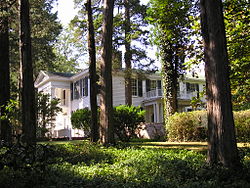Rowan Oak
William Faulkner House | |
U.S. National Register of Historic Places | |
Mississippi Landmark
| |
 Rowan Oak | |
 | |
| Location | Old Taylor Road, Oxford, Mississippi |
|---|---|
| Coordinates | 34°21′35″N 89°31′29″W / 34.3598°N 89.5247°WCoordinates: 34°21′35″N 89°31′29″W / 34.3598°N 89.5247°W |
| Built | 1844 |
| Architect | Col. Robert Sheegog |
| Architectural style | Greek Revival |
| NRHP reference No. | 68000028 |
| USMS No. | 071-OXF-0502-NHL-ML |
| Significant dates | |
| Added to NRHP | May 23, 1968[2] |
| Designated NHL | May 23, 1968[3] |
| Designated USMS | January 15, 1986[1] |
Rowan Oak is William Faulkner's former home in Oxford, Mississippi. It is a primitive Greek Revival house built in the 1840s by Colonel Robert Sheegog, an Irish immigrant planter from Tennessee. Faulkner purchased the house when it was in disrepair in 1930, and did many of the renovations himself. Other renovations were done in the 1950s. One of its more famous features is the outline of Faulkner's Pulitzer Prize–winning novel A Fable, penciled in graphite and red on the plaster walls of his office. It is now owned and operated by the University of Mississippi as a museum, and is open to visitors year-round.
History[]
The house sits on four landscaped acres, surrounded by 29 acres of woods known as Bailey Woods. The original owners, The Sheegogs, lived in the home from 1844-1872. In 1872, the Bailey family purchased the home and resided there until 1923. The property was then unoccupied for 7 years until William Faulkner purchased it in 1930.
Faulkner renamed the property "Rowan Oak" after the rowan tree of Scotland, symbolizing peace and security, and the live oak, symbolizing strength and solitude. Neither of those trees can be found on the property, but the grounds and surrounding woods of Rowan Oak contain hundreds of species of native Mississippi plants, most of which date back to antebellum times. The alley of cedars that line the driveway were common in the 19th century, as it was believed that cedar trees purified the air of the yellow fever virus. Rowan Oak was William Faulkner's private world, in reality and imagination, and he was fascinated with its history. Faulkner's years at spent at Rowan Oak were productive as he set stories and novels to paper, ultimately winning the Nobel Prize for Literature in 1949, and the Pulitzer Prize and National Book Award for A Fable in 1954.
In 1972, the University of Mississippi purchased Rowan Oak. The home is preserved as it was at the time of Faulkner's death in 1962. The University maintains the home in order to promote Faulkner's literary legacy, and it is open to visitors year-round. The home has been visited by such writers as John Updike, Czesław Miłosz, Charles Simic, Richard Ford, James Lee Burke, Bei Dao, Charles Wright, Charles Frazier, Alice Walker, the Coen brothers, Bobbie Ann Mason, Salman Rushdie, and others. Writer Mark Richard once repaired a faulty doorknob on the French door to Faulkner's study.
Rowan Oak was declared a National Historic Landmark in 1968.

The current curator of Rowan Oak is William Griffith. Past curators include the novelists Howard Bahr and . The original curator was Bev Smith, an Ole Miss alum, who was responsible for finding a great deal of Faulkner's original manuscripts hidden within the closet under the stairs in the home.
References[]
- ^ "Mississippi Landmarks". Mississippi Department of Archives and History. May 2008. Retrieved May 13, 2009.
- ^ "National Register Information System". National Register of Historic Places. National Park Service. January 23, 2007.
- ^ "William Faulkner House". National Historic Landmark summary listing. National Park Service. Archived from the original on 2011-06-06. Retrieved 2007-10-25.
External links[]
| Wikimedia Commons has media related to Rowan Oak. |
- https://www.rowanoak.com -Official Website that includes visitor information, business hours, and more
- Inside Rowan Oak: short video about Faulkner and Rowan Oak, with Close-Ups of a Novel Draft that Faulkner Wrote on His Office Wall
- A Photo Tour of Rowan Oak, With Commentary
- William Faulkner on the Web - Includes detailed, interactive map of the grounds
- "Writings of William Faulkner", broadcast from Rowan Oak from C-SPAN's American Writers
- William Faulkner
- Houses completed in 1844
- Houses in Lafayette County, Mississippi
- National Historic Landmarks in Mississippi
- Historic house museums in Mississippi
- University of Mississippi
- Museums in Lafayette County, Mississippi
- Biographical museums in Mississippi
- Literary museums in the United States
- Mississippi Landmarks
- National Register of Historic Places in Lafayette County, Mississippi
- Homes of American writers


